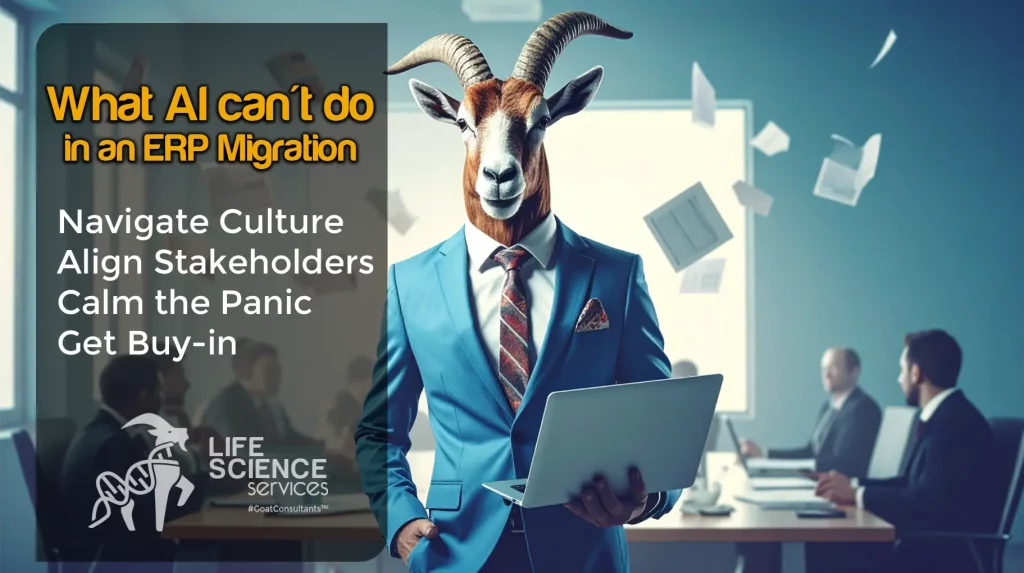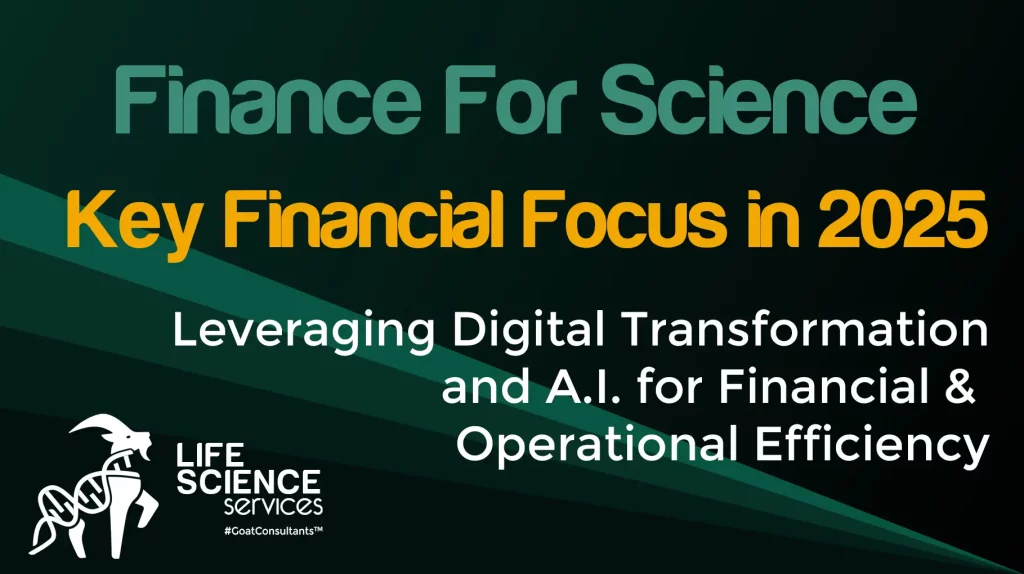What AI Can’t Do In An ERP Migration

What AI Can’t Do In An ERP Migration
AI can crunch data fast but it can’t align teams, resolve conflicts, or drive adoption. That’s where an ERP Transition Manager steps in. They translate chaos into clarity, bridging strategy and execution to ensure your ERP upgrade actually delivers.
Key Financial Focus for Life Sciences in 2025: The Five Pillars of Financial Excellence

In 2025, finance teams in small and mid-tier life sciences companies are transitioning from traditional roles to become enablers of innovation. This evolution is guided by five key pillars:
1. Capital Allocation: Prioritizing strategic planning to balance cost efficiency with investment in high-return areas, ensuring sustainable growth.
2. Diversifying Revenue Streams: Reducing reliance on single income sources by exploring licensing deals, partnerships, and geographic expansion to mitigate market volatility.
3. Mergers & Acquisitions Trends: Adapting to M&A landscapes influenced by GenAI and ESG priorities, requiring agile strategies and leveraging niche expertise to stay competitive.
4. Regulatory and ESG Compliance: Proactively integrating stringent regulatory requirements and robust ESG practices to build trust and long-term value.
5. Digital Transformation and AI: Embracing AI-driven insights and automation to eliminate inefficiencies, allowing finance teams to focus on strategic initiatives.
By focusing on these pillars, finance teams can effectively navigate the evolving landscape of the life sciences industry in 2025.
Leveraging Digital Transformation and AI for Financial and Operational Efficiency in 2025

In 2025, digital transformation and AI are fundamentally reshaping financial and operational landscapes in the life sciences sector. CFOs and executives in pharma, biotech, medtech, and biopharma are adopting strategic approaches to navigate these changes effectively. Key priorities include automating routine tasks to free up resources for strategic activities, leveraging real-time data analytics for informed decision-making, integrating cloud-based ERP solutions with AI tools for scalability and continuous innovation, and enhancing cybersecurity measures to protect sensitive data. Effective data management is crucial, as AI’s success depends on accurate, complete, and structured data. Investing in robust data governance frameworks ensures data quality and integrity, positioning businesses for long-term success in this evolving landscape.
Future of Healthcare 2025: Mastering Regulatory Landscapes

Regulatory shifts and ESG integration are reshaping life sciences. The EU Data Act (Sept 2025) mandates easier access to user-generated data, while the Biotech Act enforces stricter guidelines for gene therapy and personalized medicine in both the EU and US. ESG principles are now essential for investor trust and long-term growth. To stay competitive, companies must embrace compliance, sustainability, and digital transformation.
How Small and Mid-Tier Life Sciences Companies Can Shape M&A Trends in 2025

In 2025, small and mid-tier life sciences companies are significantly influencing mergers and acquisitions (M&A) by leveraging innovation, flexibility, and niche expertise. These agile firms excel in developing cutting-edge therapies and technologies, particularly in specialized markets like rare diseases and personalized medicine, making them attractive partners for larger organizations. Their ability to adopt creative deal structures, such as revenue-sharing models and joint ventures, allows for scalable growth without full integration. Additionally, the use of AI-driven tools in due diligence processes enhances transparency and accelerates deal execution, setting new industry standards. By embracing these strategies, small and mid-tier companies are not only attracting lucrative deals but also redefining M&A dynamics in the life sciences sector.
Diversifying Revenue Streams Beyond Core Products

In an increasingly competitive life sciences landscape, CFOs of small and mid-cap pharma and biotech companies are strategically diversifying revenue streams to address patent cliffs and market uncertainties. This shift goes beyond risk mitigation to ensure sustainable growth and innovation. From digital health technologies to strategic alliances, diversification has become critical for success in 2025. Companies are moving beyond traditional drug development to explore digital therapeutics, AI-driven diagnostics, and personalized medicine solutions. This evolution is especially vital for smaller players competing with larger pharmaceutical companies. Through diversification, companies protect against market volatility while driving healthcare innovation. Digital technologies and strategic partnerships create new opportunities in the evolving healthcare landscape.
Capital Allocation and Cost Efficiency in Life Sciences

Small and mid-cap life sciences companies face mounting pressures in 2025. With increasing market volatility, limited resources, and fierce competition, many CFOs are struggling to direct capital allocation and cost efficiency effectively. Inefficient capital allocation not only slows innovation but can also lead to missed growth opportunities, delayed product launches, and financial instability. If left unresolved, these challenges could jeopardize strategic priorities, reduce shareholder confidence, and compromise long-term sustainability. For companies in biotech, pharma, and biopharma, the stakes are especially high as competition intensifies and access to funding tightens. CFOs must act decisively to align resources with business goals and ensure efficient financial operations.
Mastering Licensing Agreements Financial Management for Life Sciences Success

Effective financial management of licensing agreements is crucial for small and mid-tier life sciences companies, as these agreements provide essential funding and strategic collaboration opportunities. To navigate the complexities of licensing, companies should adopt best practices such as aligning milestone payments with key value-driving events like clinical trial successes, tailoring royalty structures to market realities through tiered models, and leveraging modern ERP systems. These systems offer integrated project management and real-time tracking of milestones and costs, enhancing transparency and efficiency. By implementing these strategies and utilizing advanced financial tools, companies can foster innovation, mitigate risks, and build partnerships that drive the development of life-changing therapies.
Is Finance The Weak Link in Biotech Innovation?

In 2025, financial innovation is pivotal for small and mid-tier life sciences companies aiming to navigate complex licensing agreements effectively. Implementing modern Enterprise Resource Planning (ERP) systems is essential, as they centralize data, automate tasks, and integrate AI capabilities, thereby enhancing financial operations. By adopting best practices and leveraging technology, companies can build partnerships that foster innovation, mitigate risks, and deliver life-changing therapies to patients worldwide.
Poor Cash Flow Reporting Holds Back Life Sciences Innovation

Finance teams in small to mid-cap pharma and biotech face complex cash flow management issues under both US GAAP and IFRS. Cash flow statements often reveal a troubling gap: they lack the actionable insights needed for strategic decisions. In an industry where every dollar counts, failing to address these limitations jeopardizes a company’s financial agility and its survival. Major pain points include the pressure to classify cash flows accurately as operating, investing, or financing activities, and the added complexity of foreign currency transactions due to fluctuating exchange rates. Mergers and acquisitions further complicate reporting, requiring precision in separating acquisition-related expenses and liabilities. Additionally, transactions like contingent considerations and stock compensation arrangements bring unique challenges in presenting clear and accurate cash flows, often leading to confusion and restatements.
The Value of Your Company Unveiled Thanks to Modern ERP Financial Reporting

In small and mid-cap life sciences companies, finance teams are stuck in legacy accounting practices that stifle innovation. Bloated Excel sheets, convoluted explanations, and feedback loops that feel more like interrogations leave R&D teams frustrated and distracted. These outdated processes don’t just waste time—they erode the value of R&D itself. It’s time for non-finance leaders to demand streamlined, transparent tools that support growth, not block it.
As a result, the journey from lab to market hinges on the seamless integration of R&D with strategic financial oversight.
Below, we explore why CFOs – and stakeholders – must rethink their approach, replacing outdated methods with more modern and integrated solutions to protect and amplify R&D success.
Outdated Accounting Practices Hold Back R&D Success

In small and mid-sized life sciences companies, outdated accounting methods in finance are causing more harm than meets the eye. Legacy systems—marked by complex Excel spreadsheets and lengthy feedback loops—are overwhelming R&D teams. These inefficient practices waste time and drain the value of R&D, leading to delays in innovation. It’s time for non-finance leaders to push for streamlined, transparent accounting tools that drive progress rather than hinder it. The path from lab to market depends on integrating R&D with modern, strategic financial oversight. CFOs and stakeholders must embrace up-to-date, integrated solutions to secure R&D success and company growth.
Outdated Accounting Processes Hinder Revenue Recognition Efficiency

Outdated accounting processes in small and mid-sized life sciences companies significantly hinder revenue recognition efficiency. Reliance on legacy systems and manual methods leads to inaccuracies and delays, especially when scaling operations. To address these challenges, companies should modernize their financial processes by implementing advanced ERP systems and adopting automation. These changes will improve accuracy, efficiency, and scalability, ensuring compliance with revenue recognition standards like ASU 2014-09 and IFRS 15. By upgrading systems, companies can streamline revenue recognition, ensure compliance, and drive growth. 
Key Pitfalls to avoid for U.S. Biotech Firms when settling in Europe

In this article we would like to share our experiences in the most common and recurring pitfalls that US Biotech companies do when going global and coming to Europe. We will address four key areas: The views expressed in this article are different from the established norms, but we believe they reflect today’s reality. Because many HQs are now employees-less, resulting in millions paid in unnecessary leasing costs: how many employees work from home, in countries which are thousands of miles away from “the office”? This represents a significant tax risk for companies if your Key Positions do not reflect the reality of your structure. The unprecedented times we live will accelerate policy changes in the way we live, work and get taxed. European Landscape Despite the single market, every EU country has different regulatory requirements and laws. Payer requirements and reference pricing systems also varies from one country to the other. And not to minimize multiple languages and cultural differences. Common pitfall? Do not assume that habits and processes are the same in France and Germany, or Italy and Spain… As an example, in some countries you can create a company in as little as 24 hours, and some countries may require 3 months! Implementation Strategy – Which Biotech hub? If the General Manager is the obvious first hire, which position should come next? When should Health Economics and Outcomes Research (HEOR) and Health Technology Assessment (HTA) being considered? Common pitfall? Building solid tools that support decision-making take time and reaching out to Payers requires patience. It’s never too early to think Market Access. What is the appropriate infrastructure and business process? Looking from the US, the European Biotech “places to be” seems very fragmented! Every country has its own ranking: if Switzerland is the leading country for patents, mostly because of advantageous IP Box fiscal structure, academics cooperation and grants are relatively poor compared to UK and Germany. Spain, Catalonia, is the place to be for Digital Health & Big Data, Biomedical Sciences and Genomics, and offers good access to capital and tax incentives too! Common pitfall? A central HQ is no longer the norm. To take advantage of the many European hubs, think competency centres. It’s also the most efficient way to build a rich, diverse culture. IP Considerations and Taxes “Cost +” is dead. New OECD rules and taking advantage of Biotech Hubs across Europe lead to more complex profit-split and profit-sharing methods in group companies. A balanced Infrastructure designed to maximize your Value Chain and with the appropriate Key Functions are key factors to de-risk inter-company transactions and IP recognition. Common pitfall? Too many companies pay unnecessary taxes because of intercompany transfer pricing. Conducting clinical trials in Europe? Do not underestimate the importance of VAT (Value Added Tax) & Customs compliance. All goods have a customs value and therefore are taxable. Incorrect filing could lead to heavy fines and license bans. In addition, with an average rate of 15% around Europe, recovering VAT could lower your costs. Common pitfall? Do not underestimate the importance of VAT (Value Added Tax) & Customs compliance. Incorrect customs documents can lead to high penalties and dramatic damage to your company reputation vis-à-vis of clients. As buyers, or receivers, are ultimately liable for the taxes in cross-border operations. Digitalization : dilemma or paradigm shift? FDA CFR – Title 21, General Data Protection Regulation (GDPR), HIPAA, SOX… How to handle (patients) data protection, privacy, in a patchwork of different regimes? Extra-territorial laws impacts can arise depending on where your data is stored. In a world that is interconnected with an increasing need for true collaborative interactions, you must ensure that your Cloud in protected and with efficient compliance programs. Common pitfall? The IT department is often disregarded in strategic decisions about software integration. A global view is necessary to ensure harmonization and interconnection across all companywide systems.
SAP talks about us!

SAP talks about us! Ichnos Sciences is a fully integrated biotechnology company headquartered in New York City with an Innovation Hub and Manufacturing operations in Switzerland. Focused in research and innovative, transformative solutions on the frontiers of oncology and autoimmune diseases, Ichnos Sciences seek to treat patients holistically, by targeting diseases and their consequences on the human body on multiple levels. The Need Benefits Finance & Accounting Supply Chain Testing & Validation Phase 2 Implementation Serialisation Quality Why SAP Business ByDesign? Ichnos chose LifeScience Services as Project Managers to support the successful implementation of SAP Business ByDesign, a No Code Scalable ERP with a phased implementation approach. Learn more about financial management in the life sciences.
What is transfer pricing ?

This article will provide you with a high-level methodology for the different methods and types of transfer pricing. You will not become a tax expert, but next time you will be asked the question “what is your transfer pricing method”, you probably won’t respond “Cost +”… Multinational companies, MNE, used to allocate profits (earnings before interest and taxes – EBIT) among its various subsidiaries, generally in “tax friendly” countries to benefit from double non-taxation. However, since the financial crisis in 2008, the G20 countries put tax, specially tax avoidance, on the top of their agenda. In 2012 a plan against Base Erosion and Profit Shifting was elaborated. BEPS was just born. The Article 9 of the OECD Model Tax Convention on Transfer Pricing regulations require transfer prices within a controlled group to meet the arm’s length principle. In other words, transactions between related parties must take place under market conditions. The arm’s length principle provides broad parity of tax treatment for members of MNE groups and independent enterprises as it avoids the creation of tax advantages or disadvantages that would otherwise distort the relative competitive positions of either type of entity. There are five different transfer pricing methods in two categories: Regardless of the method, master and local files as well as international comparable transactions are required. The traditional transaction methods, commonly and wrongly called “Cost +”, are used for a wide range of operations such as purchase ans sale of commodities (goods), lending money and services. Generally the transactions are straight forward and the margins involved are rather small. Transactional profit methods require a profound analysis of routine and non-routine transactions and the elements of the value chain of the companies involved. It details risks occurred by participant companies and the margins at play are potentially higher. If the latter is more complex, it has a significant benefit for the companies which implement it; tax transparency across several jurisdictions. You can continue reading the chapters below to gain a comprehensive and high-level understanding of transfer pricing. 1. Overview of transactions 2. OECD Transfer Pricing Guidelines & the Arm’s Length Principle 3. Functional and risk analysis 4. Transfer pricing analysis 5. When to apply traditional transaction methods? Subject to the guidance in paragraph 2.2 of the OECD Guidelines for selecting the most appropriate transfer pricing method in the circumstances of a particular case, generally it is assumed that: 6. When to apply Transactional profit methods? While in some cases the selection of a method may not be straightforward and more than one method may be initially considered, generally it will be possible to select one method that is apt to provide the best estimation of an arm’s length price. However, for difficult cases, where no one approach is conclusive, a flexible approach would allow the evidence of various methods to be used in conjunction. In such cases, an attempt should be made to reach a conclusion consistent with the arm’s length principle that is satisfactory from a practical viewpoint to all the parties involved, considering the facts and circumstances of the case, the mix of evidence available, and the relative reliability of the various methods under consideration. TNM method PSM method This method was revised by Action 10 of the action plan against Base Erosion and Profit Shifting (BEPS) in June 2018. PSM may be considered the most appropriate transfer pricing method in a specific set of circumstances only: Besides the constraints already mentioned in the previous paragraph it is also important to indicate when it may not be appropriate to use the PSM: Despite it’s complexity, the PSM is being largely adopted because it enhances tax transparency specially for companies subject to Country-by-country reporting (CbCR) as the tax authorities have a complete view of the routine and non-routine thanks to the analysis of the value chain. As the profits are jointly shared, it is likely to satisfy the tax administrations of the parties involved. Sources: OECD Transfer Pricing Guidelines for Multinational Enterprises and Tax Administrations ISBN 978-92-64-26512-7 report_on_the_application_of_the_profit_split_method_within_the_eu_en.pdf (europa.eu)
What is Shadow Payroll?

Today’s workforce is mobile, and COVID-19 pandemic has accelerated this trend. France, Italy, Germany and even Belgium, Netherlands and UK… It is not unusual to hear that people returned to their home country and are working remotely. Can this practice have an impact on companies and the way payroll is handled? Yes, it does. As the current situation may last longer than expected, if a company has employees working from a different country they have to be considered as “expats”. Nations are more demanding and local tax jurisdictions are increasing pressure on people’s income tax and shifting the burden of taxation to employers, many things can go wrong for companies which will be required to pay heavy fines. Let’s use the following example: “Max is British. He lives in Basel and works for a Swiss based pharma company (home country). In March 2020, because of the COVID-19 pandemic, Max decides to work from his home in the UK (host country), and travel to Switzerland when required , usually one day per month for on-site meetings. Max’s plans are to return to Switzerland when his company’s office opens again, which is planned in March 2021.” How shall this case be treated? Generally, double taxation treaties apply for assignments that are less than 6 months. As the stay is longer than 183 days, it is considered a long-term assignment and Max’s income may be subject to tax in the host country (UK). In this case Max’s company is required to implement a shadow payroll and pay for the social security in the host country. What is Shadow Payroll? Shadow payroll is a method to assist and comply with international payroll and tax regulations while an employee has a different host country. As the payroll is shadowed in the host country, it generally requires the home country company to register as taxpayer in the host country or to have a local subsidiary or branch to be registered. It is a complex process, which requires detailed knowledge and expertise! For further information, please:
Work from home, employers obligations in the EU big 6 and Switzerland

Continuing with our “work from home” series, we would like to share with you in the table below and the file attached our findings about the discrepancies of the work from home laws in the 6 biggest European countries and Switzerland. Do not hesitate to download the table and the references by clicking the file below.
Future Tax Policy for Digital Economy

The digitalization of the economy remains an important tax challenge and was identified as an area of focus of the Base Erosion and Profit Shifting (BEPS) Action Plan. With the objective to change the actual profit allocation rules for digital companies two Pillars were identified: Grouped under an Inclusive Framework (“IF”), the Program of Work (“PoW”) was initiated in May 2019 by the G20 ministers jointly with the OECD. Following several revisions, the IF and OECD adopted a consensus based solution on Pillar One: the “Unified Approach”. On January 31, 2020, the OECD endorsed the Pillar One and approved to negotiate its principles under the Unified Approach which is intended to be finalized by 2020. The proposal would have to be adopted by the G20 before getting implemented in the various jurisdictions. The concept is to design a solution that attracts support from all members of the Inclusive Framework. The Secretariat’s proposal for a “Unified Approach” has been developed with this goal in mind. Key features of a solution, which would include the following: Scope. New Nexus. New Profit Allocation Rule going beyond the Arm’s Length Principle. Increased Tax Certainty delivered via a Three Tier Mechanism. To summarize, reaching a consensus amongst 137 countries participating in the IF is a great challenge, but the IF has already shown a huge determination in bringing the Unified Approach in such short notice. In an ever evolving landscape of regulations*, we recommend multinational companies to develop contingency plans, change scenarios and implementation without delay. For further information: simon.massel@lifescienceservices.ch Source: http://www.oecd.org/ *US GOP Tax Reform, the EU Anti-Tax Avoidance Directives (“ATAD I” and “ATAD II”), BEPS Action Plans, Pillars One and Two
Tax opportunities post COVID-19

With the sudden appearance of COVID-19, many businesses encounter tough and violent challenges as shut down with a loss of revenue and removal of production capacity. The preservation of the EBIT and especially the cash is critical. Therefore companies should focus on completing their 2019 tax credits on R&D might help to obtain cash refunds from the governments. As part of the various public states measures, urgent tax incentives have been introduced such as: Such measures may lead several countries to raise their tax rates and tax conditions in the coming years. The world post COVID-19 remains uncertain and companies may rethink their value chain process by using tax design to improve their bottom line results. Opportunities 1. Transfer pricing activity reorganization In context of an economic downturn, tax-group reorganization is more favourable as it triggers lower valuation in respect of transfer of business activities, goodwill, Intellectual Property (IP). Restructuring allows to benefit from the negative context to redesign the transfer pricing group policy by calibrating the benchmarks and efficiently re-streamline the generation of the value added creation in more tax efficient locations. In addition, tax losses generated during 2020 might be optimally utilized to reduce the exit tax impact. 2. Revisit of existing transfer pricing flows The negative economic context offers possibilities to recalibrate the transfer pricing remuneration by streamlining the benchmarks. This may decrease the net income of the group subject to corporate tax in the various jurisdictions. 3. CFC – Controlled Foreign Company rules. Group subject to CFC rules may also benefit from a favourable re-design in term of shareholding. Reorganizing the shareholding flows as well as the adequate level of substance might allow to minimize and optimize the negative impact of these rules. As a conclusion, the world post COVID-19, remains uncertain and companies may take this opportunity to rethink their value chain process by using tax design to improve their bottom line results. It is the right to elaborate a tax risk-benefit assessment. Please feel free to contact us for more information. Simon Massel
What will impact the CFOs lifes in 2018?

As world is accelerating, every year faster, to more digital and all-service economy, 2018 will be a pivotal year for the finance function. You may have read similar comments in the past years, but you have not seen many changes in the finance functions. You still: Is this your budgeting process? If yes, I am afraid to inform you that you missed the train… However, 2018 is the perfect year to catch up. You believe that only “digital companies” are concerned by new laws and directives and as you run a traditional business it does not apply to your company. Once again, I am afraid to inform you that every company is a technology company now. You are not convinced? Please answer the following questions: If you answered “yes” to any of the questions above it means that your company is a technology company, at least in the opinion of the OECD and your country tax department. Hereafter we will present you what topics we foresee as game changers in 2018, with their risks and opportunities: Cloud Technology savvy people will think that “the Cloud” is no longer a disruptive technology. It is a false statement for the finance function. Planning, budgeting and forecasting (PBF) is widely out of scope when companies move to the cloud: only 10-15% of companies have moved PBF to cloud based solutions. The reasons for such a low conversion to the Cloud are numerous but the most common are: Whilst companies which have moved PBF to the cloud report the following benefits: What are the risks if your company does not migrate the PBF (and other functions) to cloud based solutions: To summarize, the first step in modernizing the finance function is to move the operations to the cloud but make sure you implement the adequate processes, rather than copy/paste your current processes. Blockchain Blockchain is the foundation of crypto-currencies such as the Bitcoin. The Wikipedia definition of blockchain: “it is a continuously growing list of records, called blocks, which are linked and secured using cryptography. Each block typically contains a hash pointer as a link to a previous block, a timestamp and transaction data. By design, blockchains are inherently resistant to modification of the data.” We often read terms such as “the supply chain blockchain” or the “finance blockchain”. In fact, Supply Chain and Finance are blocks linked to the same list of records. To summarize, blockchain is your product/service/transaction DNA, or genetic code. Why should CFOs consider adopting blockchain technologies? In addition to the business and finance partners pressure, the benefits of adopting the blockchain technology are: Of course, adopting such an early technology has it risks, and pursuing a full integration of blockchain could be very expensive to early adopters: To summarize, auditors perceive the blockchain ledgers to have the potential to solve the problems associated with standardisation, reliability and compliance. The fact that blockchain has received the confidence of all major financial institutions (banks, insurances, VCs) may force corporations in the need of funding to adopt it. In our opinion, it is difficult to predict exactly how huge the impact of the blockchain will be on the finance function. Artificial Intelligence (AI) AI and blockchain are inseparable. However, unlike blockchain, AI is perceived as a threat to the finance function: Natural language processing (NLP) and Robotic process automation (RPA) are concepts which are already being tested by Big4 companies. Big4 are already playing the game of men versus machines. RPA technology is being compared and benchmarked versus human brains. They use comparative methods to fine tune machines conclusions using human thinking. In the meantime, NLP is used to fill in hundreds of thousands of standard documents such as leasing contracts. Contracts are reviewed by real persons using the same sample criteria as any financial audit. Big4 companies can afford the luxury to test and roll out these technologies while having clients paying them for what is a massive UAT (user acceptance testing). In the short term (1-2 years), we do not recommend to CFOs to go on the direction of AI. We would rather recommend investing in cloud and blockchain solutions. ROI to implement AI technologies could be fast, but only for companies treating huge amount of transactions in millions. In the mid-term (3-5 years) we believe that AI technologies will play a significant role in fraud detection: if audits used to be based on samples, AI technologies will be able to review entire blocks of data downstream and upstream. As an example, AI technologies will recognize a fraudulent payment to a party under Anti-bribery and/or FCPA regulations. In addition, travel expenses will no more be a hassle for the accounting teams: NLP technologies will be able to code and process any expense claim, in line with the company travel policy with milliseconds! Our conclusion about AI is that it will simplify the world of finance and translate complex transactions into comprehensive steps. We don’t see AI as a threat to the finance function but as a perfect tool to support decision making by providing unquestionable proof of concept. Stay tuned for the next article. About the author: Rui M. Teixeira is a finance professional with over 20 years’ experience including 10 as independent management Consultant. The objectives of his articles are to share his professional experiences and feelings about the professional world. Disclaimer Unlike Big4, large consultancy firms and the EU Commission, our company does not have dedicated resources to research and investigate about the current trends which impact the world of business. You will understand that we do not openly share our sources. However, if there is a piece of information for which you would like to see the source/reference or to further discuss it, please do not hesitate to contact us specifying what paragraph you are looking for.
